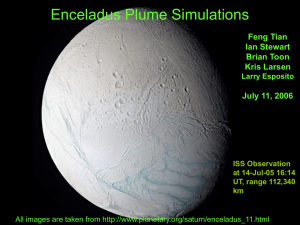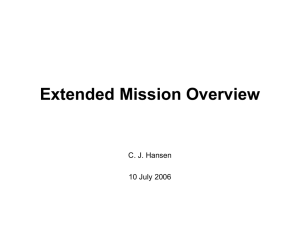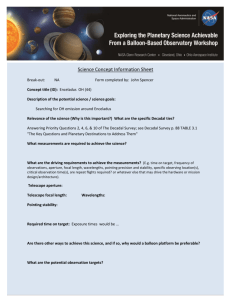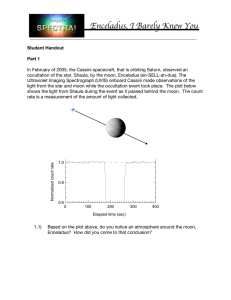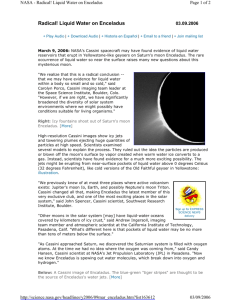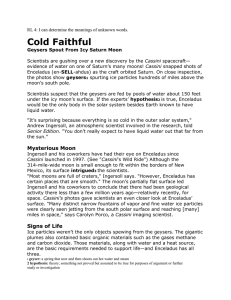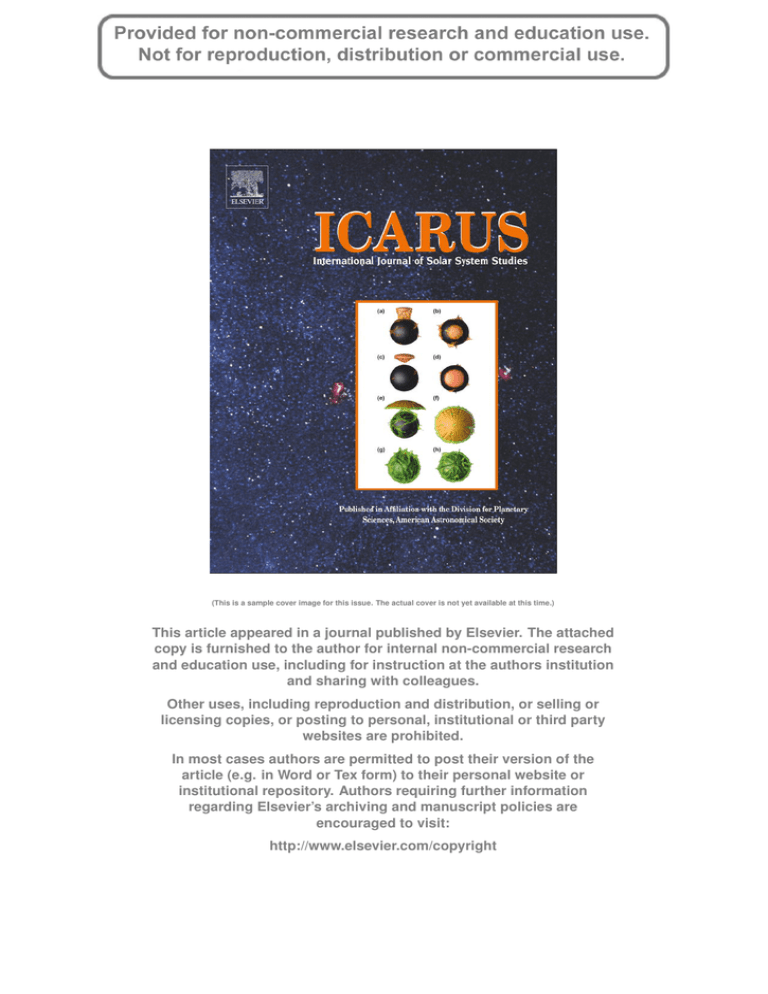
(This is a sample cover image for this issue. The actual cover is not yet available at this time.)
This article appeared in a journal published by Elsevier. The attached
copy is furnished to the author for internal non-commercial research
and education use, including for instruction at the authors institution
and sharing with colleagues.
Other uses, including reproduction and distribution, or selling or
licensing copies, or posting to personal, institutional or third party
websites are prohibited.
In most cases authors are permitted to post their version of the
article (e.g. in Word or Tex form) to their personal website or
institutional repository. Authors requiring further information
regarding Elsevier’s archiving and manuscript policies are
encouraged to visit:
http://www.elsevier.com/copyright
Author's personal copy
Icarus 220 (2012) 29–35
Contents lists available at SciVerse ScienceDirect
Icarus
journal homepage: www.elsevier.com/locate/icarus
UV spectrum of Enceladus
Mark Zastrow a,⇑, John T. Clarke a, Amanda R. Hendrix b, Keith S. Noll c
a
Center for Space Physics, Boston University, 725 Commonwealth Ave., Boston, MA 02215, United States
Jet Propulsion Laboratory, California Institute of Technology, Mail Stop 230-250, Pasadena, CA 91109, United States
c
Space Telescope Science Institute, 3700 San Martin Dr., Baltimore, MD 21218, United States
b
a r t i c l e
i n f o
Article history:
Received 1 December 2011
Revised 1 April 2012
Accepted 3 April 2012
Available online 21 April 2012
Keywords:
Saturn, Magnetosphere
Saturn, Satellites
Enceladus
Ices, UV spectroscopy
a b s t r a c t
We present a far ultraviolet (FUV) spectrum of Saturn’s moon Enceladus from the Cosmic Origins Spectrograph (COS) on the Hubble Space Telescope (HST). We have put upper limits on emission from C, N,
and O lines in Enceladus’ atmosphere and column densities for the C lines assuming solar resonance scattering. We find these upper limits to be relatively low—on the order of tens to thousands of Rayleighs and
with C column densities on the order of 108–1015 cm2, depending on the assumed source size. We also
present a segment of a reflectance spectrum in the FUV from 1900–2130 Å. This region was sensitive to
the different ice mixtures in the model spectra reported by Hendrix et al. (Hendrix, A.R., Hansen, C.J.,
Holsclaw, G.M. [2010]. Icarus, 206, 608). We find the spectrum brightens quickly longward of 1900 Å,
constraining the absorption band observed by Hendrix et al. from 170 to 190 nm. We find our data is
consistent with the suggestion of Hendrix et al. of the presence of ammonia ice (or ammonia hydrate)
to darken that region, and also possibly tholins to darken the mid-UV, as reported by Verbiscer et al. (Verbiscer, A.J., French, R.G., McGhee, C.A. [2005]. Icarus, 173, 66).
Ó 2012 Elsevier Inc. All rights reserved.
1. Introduction
Seven months after the Cassini spacecraft arrived in the saturnian system in July 2004, its first flyby of Enceladus encountered
striking magnetic disturbances. The field lines were draped around
the moon as if it were obstructing the plasma flow, suggesting a
strong electromagnetic interaction (Dougherty et al., 2006). Closer
encounters on later passes revealed spectacular geysers of fine icy
particles feeding a large plume spewing from the ‘‘tiger stripes’’—
surface fractures in geologically youthful and rugged terrain in
the southern polar region of Enceladus (Porco et al., 2006). This
finding raised the tantalizing possibility of a subsurface ocean of liquid water. It also shed light on Enceladus’ role within Saturn’s
magnetosphere, suggesting it is one of its main sources of plasma.
Stellar occultation observations by Cassini’s Ultraviolet Imaging
Spectrograph (UVIS) and direct measurements from the Ion Neutral Mass Spectrometer (INMS) confirmed the southerly existence
and water ice composition of the plume and suggested a source
of 200 kg s1 of H2O (Hansen et al., 2006, 2011; Waite et al.,
2006). Burger et al. (2007) used a 3-D Monte Carlo model to simultaneously model the UVIS column density and INMS water gas
density results. They found the data were consistent with a twocomponent atmosphere: a thin global H2O atmosphere with a slant
column 1013 cm2 neutral density and a source rate of
⇑ Corresponding author.
E-mail address: mzastrow@bu.edu (M. Zastrow).
0019-1035/$ - see front matter Ó 2012 Elsevier Inc. All rights reserved.
http://dx.doi.org/10.1016/j.icarus.2012.04.002
1026 H2O s1, and a much larger localized plume with a source
of 1028 H2O s1 (300 kg s1). From this neutral water source, they
estimated a magnetospheric plasma mass loading rate (via charge
exchange) of 2–3 kg s1. Khurana et al. (2007), working from
magnetic field flyby data, estimated a similar plasma mass loading
rate of 0.6–2.8 kg s1, based upon the inference of a pickup source
size of 4 REn (where 1 REn = 250 km).
However, the plasma deflections at Enceladus were recorded by
the Cassini Plasma Spectrometer (CAPS) at distances as large as
30 REn from Enceladus (Dougherty et al., 2006; Tokar et al.,
2006), implying an electrodynamic interaction between Saturn’s
magnetosphere and Enceladus that requires a much larger mass
loading rate. As detailed by Pontius and Hill (2006), depending
on the coupling model used, the source rate can be taken to be proportional to either the Pedersen conductivity of Saturn’s ionosphere or the Alfvén conductivity in the Alfvén wings near
Enceladus. The plausible range of those parameters implies, at
minimum, a plasma mass loading rate of order 100 kg s1. According to this evidence, Enceladus’ role at Saturn appears to be analogous in nature to that of Io’s at Jupiter—a mass loading region
comparable in extent, and interacting strongly with Saturn’s corotating magnetic field and plasma.
Such magnetospheric planet–satellite interactions have been
the subject of intensive research for decades, with particular insight gleaned from the Galilean moons of Jupiter (see Kivelson
et al., 2004). The electric potential induced by a satellite’s movement relative to the magnetic field drives ionospheric currents,
Author's personal copy
30
M. Zastrow et al. / Icarus 220 (2012) 29–35
as well as a pickup current as newly ionized particles are incorporated into the plasma flow (Goertz, 1980; Hill et al., 1983). These
currents propagate as shear Alfvén waves along magnetic flux
tubes to the planet’s ionosphere (Neubauer, 1980). At Jupiter, these
produce bright auroral emissions (10–100 kR, where
1 kR = 109 photons cm2 s1 into 4p steradians) located equatorward of the main auroral oval at the magnetic footprint of the field
line threading each satellite (Clarke et al., 2004). The currents can
also produce auroral emission at the satellites, which has been detected at Io (Roesler et al., 1999) and Ganymede (Hall et al., 1998;
Feldman et al., 2000).
Auroral evidence for the magnetospheric interaction has also
been sought in the case of Enceladus. A study by Wannawichian
et al. (2008) put an upper limit on any auroral footprint on Saturn
to be a few kR, and the auroral footprint was definitively detected
by Pryor et al. (2011) using Cassini UVIS. Three detections of the
footprint in the extreme ultraviolet (EUV) and the far ultraviolet
(FUV) were reported, with brightnesses varying by a factor of 3,
from 450 Rayleighs to 1550 R. They suggest that this range in
brightness is driven by variability in the cryovolcanism at the tiger
stripes. However, the relative faintness of the footprints suggests
that the bulk of the interaction could be localized near Enceladus
itself, rather than driving strong currents through the ionosphere
of Saturn. With regards to our study, this implies significant airglow/auroral emissions where the currents close near Enceladus.
The surface composition of Enceladus has also been long studied. Photometric and spectroscopic observations in the IR have
established that Enceladus’ surface is nearly pure water ice (Cruikshank, 1980; Clark et al., 1984; Cruikshank et al., 1998, 2005), but
the presence of other compounds has not been ruled out. In particular, ammonia has been suggested as another species and has been
definitively detected in the plume (Waite et al., 2009). Emery et al.
(2005) reported a possible detection of surface NH3 ice based on
spectral features near 2.0 and 2.25 lm. Verbiscer et al. (2006) presented a near-IR spectrum consistent with a mixture of as much as
20% ammonia hydrate (1% NH3H2O). Tentative detections of
ammonia in the near-IR have also been made throughout the
saturnian system—on Tethys in ground-based observations by Verbiscer et al. (2008) and in dark material seen in Cassini VIMS (Visual and Infrared Mapping Spectrometer) observations of Dione,
Phoebe, and Iapetus by Clark et al. (2008). In the UV, Cassini UVIS
observations from Hendrix et al. (2010) found that Enceladus’
spectrum in the region 170–190 nm was too dark be made of
water ice alone. Hendrix et al. (2010), through modeling of the
spectrum, suggested that this characteristic, too, could be explained by the presence of a small amount of ammonia ice (1% in
H2O). Hendrix et al. also introduced a small amount of tholins into
the mixture in order to darken the NUV portion of the spectrum
from 200 nm to 300 nm to be consistent with photometric observations by Verbiscer et al. (2005).
We present a segment of a UV spectrum of Enceladus taken
with the Cosmic Origins Spectrograph (COS) (Green et al., 2003)
on the Hubble Space Telescope (HST). We have measured possible
atomic lines of airglow species and placed upper limits on their
column densities. (We consider no molecular features due to their
relative weakness.) We also present a segment of a reflectance
spectrum from 1900 to 2130 Å, a key region that displays many
spectral features of important molecules, including the absorption
feature that Hendrix et al. (2010) suggests could be due to the presence of ammonia and/or tholins.
2. Observations
The observations were carried out over four HST orbits on May
5–6, 2010 (Table 1). Enceladus’s leading and trailing hemispheres
were observed half an Enceladus orbit (16 h) apart, near its western and eastern elongations. The solar phase angle was 4.3°.
COS is a highly sensitive UV spectrograph that features a unique
slitless design. In lieu of a slit, it has a small aperture, a small field
of view, and derives its resolving power from Hubble’s stability and
pointing capabilities (Osterman et al., 2011). All exposures were
made through COS’ Primary Science Aperture (PSA), a circular
aperture 700 lm (2.5 arcsec) in diameter (Shaw et al., 2009).
COS has both far ultraviolet (FUV) and near ultraviolet (NUV)
channels. Our observations include spectra from each channel,
using the G140L and G230L gratings in the FUV and NUV respectively. The FUV channel’s detector is a large format cross delay line
(XDL) micro-channel plate consisting of two 16,384 1024 pixel
segments (designated A and B). The NUV detector is a single
1024 1024 multi-anode micro-channel array (MAMA) that
images three separate, noncontiguous stripes of a spectrum (designated A, B, and C).
In the following results, the airglow emission analysis was conducted on segment A of the FUV channel, over a wavelength range
of 1267–1800 Å, shown in Fig. 1 smoothed to a 25 pixel (2 Å) boxcar average. Wavelengths longward of 1800 Å and all of segment B
(which covers the wavelength range 300–1095 Å) were ignored
as the signal-to-noise ratio was too low to be reliable.
In Fig. 1, we restrict the wavelengths shortward of 1320 Å to the
data from exposures taken while HST was on the nightside of the
Earth to avoid contamination of the 1304 Å feature from the geocorona. We believe, however, that much of what is detected is still
nightglow from Earth and possibly emission from the greater
saturnian magnetosphere; we have no reason to believe that any
of the observed emission is from Enceladus or its plume, as detailed below.
For the surface composition analysis, a reflectance spectrum
was obtained from stripe A of the NUV channel, restricted to the
wavelengths longward of 1900 Å up to its limit at 2130 Å (Fig. 2).
Shortward of 1900 Å, again, the instrument sensitivity was too
low to be reliable. In considering possible hemispheric differences
in albedo, we also used the spectrum from stripe B of the NUV
channel (2800–3200 Å). Throughout this paper, we will refer to
far- and near-UV wavelength ranges according to the COS nomenclature for the NUV and FUV detectors.
Table 1
Log of HST observations of Enceladus. For each grating, the exposures were split between eastern and western elongations. The wavelength ranges listed are the ranges presented
here; unreliable data was truncated from the COS spectra and the low wavelength end of the STIS spectrum. The range of resolving power for COS data was interpolated from the
published range, where the power increases roughly linearly with wavelength (Dixon and Niemi, 2010).
Epoch
Instrument
No. of
exposures
Exposure time
(s)
Grating
Wavelength range
(Å)
Resolving
power
Designation
Aperture
Aperture size
(arcsec)
May 5–6,
2010
COS
4
1330
G140L
1267–1800
2300–3500
Segment A
PSA
2.5
4
840
G230L
1906–2130
2800–3200
2400–2650
3400–3900
Stripe A
Stripe B
2
2
2400
600
G230L
1906–2700
500
52 0.5
0.5
1999–2000
STIS
Author's personal copy
31
M. Zastrow et al. / Icarus 220 (2012) 29–35
Fig. 1. FUV spectrum, used for airglow analysis; disk-averaged, smoothed to
25 pixel (2 Å) boxcar average.
Fig. 2. Segment of NUV spectrum used for surface analysis (disk-averaged,
unsmoothed).
In our analysis, we used the solar spectrum for the date of the
observation from SOLSTICE on the SORCE satellite at 1 Å resolution
(McClintock et al., 2000), convolved with the line spread function
(LSF) of COS.
3. Upper limits on airglow emission
We present upper limits on airglow emissions of O, C, and N at
various lines in Table 2. Enceladus appears essentially as a point
source to COS; with a radius of 250 km it appears with a 0.1 arcsec diameter, close to the instrument’s full width half maximum.
The calculated FWHM of the G140L grating is 1 Å across its entire
wavelength range. The upper limits on airglow were determined
by smoothing over a 2 Å (25-pixel) boxcar average, adding 2r
above the noise level from the surrounding 10 Å, and integrating
over a 2 Å wide segment for each potential feature. (Empirical LSFs
have been released for the G130M and G160M gratings in the FUV
mode, but are not yet available for the G140L grating.)
Since COS cannot spatially resolve any of the structure of the
plume or Enceladus’ atmosphere, and the actual strength of the
emission depends on the size of the emitting region, we attempt
to give a sense of the plausible range of values for the emission
by presenting three columns in Table 2. These correspond to three
cases: a global atmosphere with a simple circular cross section of
1.5 REn (375 km); a localized plume source with a circular cross
section of diameter 150 km (the width of the plume derived by
Hansen et al. (2011) from a Cassini UVIS observation of a solar
occultation on May 18, 2010, twelve days after our observations);
and the E-ring torus, which would fill the field of view of COS.
Although the PSA has a physical radius of 1.25 arcsec, aberrated
light up to 2 arcsec from its center can enter the system. However,
to derive an upper limit, we assume a field of view simply corresponding to the size of the PSA.
Any local emission that is observed could be due to either:
atomic or molecular emission, solar resonance fluorescence scattering, or reflected sunlight from the surface. By assuming solar
resonance scattering, we can calculate upper limits on the column
densities from resonance lines of carbon, also given in Table 2. We
note that O I 1356 Å is a forbidden transition and should rather be
taken as a measure of electron collisions (discussed in S5). The solar flux was determined for each emission line from the spectrum
for the date of the observations from the SOLSTICE instrument.
A prime candidate species is atomic oxygen, which has been detected in the saturnian magnetosphere from dissociation of water
molecules by Hansen et al. (2006) and Melin et al. (2009). Melin
et al. found it to be distributed in a torus centered at Enceladus’ orbit (a distance of 4 Saturn radii.) O emission has been previously
detected in the atmospheres of Europa and Ganymede at 1304 and
1356 Å by Hall et al. (1998); in the saturnian system, O2 produced
by radiolysis has been detected in the atmosphere of Rhea by Teolis
et al. (2010).
We note that although O I emission at 1304 Å can be seen in the
disk-averaged spectrum (Fig. 1), even though we have restricted
that portion of the spectrum to nightside exposures, it is easily explained by nightglow from Earth’s atmosphere and/or background
emission from the saturnian magnetosphere. Both sources would
fill the field of view of COS; in this case, we derive an O I
1304 Å emission of 1 Rayleigh. This is significantly less than the
nightglow of 7 Rayleighs observed by Chakrabarti et al. (1984)
at this line in uplooking spectra from a satellite in a polar orbit
Table 2
Upper limits on airglow emission lines obtained from COS, with column densities for C assuming solar resonance fluorescence scattering. 1 Rayleigh = 106 photons cm2 s1 into
4p steradians. Wavelength data from Ralchenko et al. (2011).
Species
OI
CI
CI
CI
C II
NI
NI
NI
k (Å)
1356
1277
1280
1561
1335
1419
1493
1743
Atmosphere (r = 1.5 RE)
Plume (r = 75 km)
Emission
(Rayleighs)
Emission
(Rayleighs)
88
17
13
45
33
42
34
360
Column density
(atoms cm2)
5.2 1012
1.2 1014
1.2 1012
4.0 1011
2200
420
320
1200
830
1100
870
9200
E-ring torus (aperture radius = 1.25 arcsec)
Column density
(atoms cm2)
1.3 1014
3.1 1015
3.0 1013
1.0 1013
Emission
(Rayleighs)
0.20
0.04
0.03
0.10
0.07
0.10
0.08
0.82
Column density
(atoms cm2)
1.2 1010
2.8 1011
2.6 109
8.9 108
Author's personal copy
32
M. Zastrow et al. / Icarus 220 (2012) 29–35
Fig. 4. Composite spectrum of COS and UVIS data with STIS spectrum overplotted
(K. Noll).
Fig. 3. Top: Composite disk-averaged spectrum, of Cassini UVIS (Hendrix et al.,
2010) and unsmoothed COS data >1900 Å. Bottom: Same, but COS data smoothed
over 25 pixel (2 Å) boxcar average.
at local midnight from an altitude of 650 km (higher than HST’s
559 km); it is also less than the saturnian magnetospheric emission
at this line detected by Melin et al. (2009) in the vicinity of Enceladus’ orbit at an intensity of 3 Rayleighs. Furthermore, the FWHM
of the feature is 7–8 Å, which is consistent with the FWHM of the
same feature as measured in previous observations of Earth nightglow contamination in HST (observing programs 11860 and
12414). Based on this evidence, we have no reason to believe that
any of our observed 1304 Å emission is from Enceladus.
4. Reflectance spectrum
The disk-averaged reflectance spectrum in the wavelength
range 1900–2130 Å is obtained by dividing the radiance measured
at HST (units of photons cm2 s1) by the radiance expected from a
Lambertian surface normally illuminated by the Sun:
I=F ¼
F En =XEn
F =p
ð1Þ
where FEn is the measured irradiance of Enceladus, and XEn is the
solid angle of Enceladus. F/p is the radiance expected from a Lambertian disk, where F is the solar irradiance (units photons cm2 s1) scaled to 9.503 AU (the heliocentric distance of
Saturn on the date of the observation).
In Fig. 3, at wavelengths shortward of 1906 Å we include the
Enceladus reflectance spectrum from Cassini UVIS taken by Hendrix et al. (2010). We note that these reflectance spectra are given
in terms of the canonical I/F with no correction for phase angle;
they are equivalent to the product of the geometric albedo times
the phase function. In Fig. 4, we overplot a portion of a spectrum
from observations from HST Space Telescope Imaging Spectrograph (STIS) carried out over 1999–2000 by Keith Noll. Our phase
angle was 4.3 degrees, while those of Hendrix et al. (2010) and Noll
were both 2 degrees. However, we do not expect this difference to
factor into our discussion of the broad spectral features.
The trailing hemisphere of Enceladus is known to be slightly
brighter than the leading hemisphere by 0.06–0.12 mag (approximately 6–12%), both in the visible (Verbiscer et al., 2005) and the
near-IR (Buratti et al., 1998; Momary et al., 2000; Verbiscer et al.,
2005, 2006). We see this effect in the B stripe of the NUV channel
(2800–3200 Å); however, in the A stripe of the NUV channel
(1906–2130 Å), we find no significant difference in the continuum
reflectivity of the two hemispheres shortward of 2105 Å (Fig. 5).
Possible mechanisms for any difference in albedo between hemispheres include micrometeoroid impacts, magnetospheric plasma
bombardment, and deposition of E-ring material (Hamilton and
Burns, 1994; Buratti et al., 1998). With respect to the possibility
of magnetospheric plasma, Enceladus’ trailing hemisphere is preferentially bombarded due to the fact that Saturn’s magnetospheric
plasma corotates faster than Enceladus at its orbital distance. In
particular, Sack et al. (1992) found that bombardment of energetic
ions tended to brighten the spectrum in the visible but darken it in
the FUV. This process would appear to be consistent with our nondetection of a brighter trailing hemisphere in the A stripe.
Another possibility is that the spectral properties of the local
material deposited by the E-ring and its source, the plume, could
account for the lack of hemispheric albedo difference in the FUV.
Schenk et al. (2011) noted that the plume and E-ring deposition,
rather than external bombardment, appeared to dominate spectral
color patterns on the surface of Enceladus and block color features
seen on other saturnian satellites. If plume and E-ring deposition is
the dominant bombardment mechanism in determining the modification of the surface reflectance of Enceladus, the lack of a hemispheric difference in albedo in the FUV could suggest that the
plume/E-ring is depositing material fast enough to counteract the
effects of micrometeoroid and plasma bombardment in this spectral region.
5. Discussion and conclusions
5.1. Airglow emission
The upper limits on the airglow emission of Enceladus are quite
low. Even assuming a small emitting region roughly the size of
Enceladus’ plume, the upper limits are in the hundreds to thousands of Rayleighs, on the same order as the faint auroral footprints
reported by Pryor et al. (2011). Similarly, the column densities for C
Author's personal copy
M. Zastrow et al. / Icarus 220 (2012) 29–35
33
Fig. 5. Comparisons of spectra of leading and trailing hemispheres from COS, smoothed to 25 pixels (2 Å) boxcar average. On the left, in the mid-UV, the trailing hemisphere
can be seen to be brighter than the leading hemisphere. On the right, in the FUV, this effect is not seen.
are low—well below the H2O upper limit of 1016 cm2 from UVIS
reported by Hansen et al. (2011). Although a plume-sized source
for C I 1280 results in an upper limit for C of 3.1 1015 cm2, or
roughly one-third the density of the H2 O plume, C I 1277 constrains it to 5 1012 cm2 or one part in 2000. (For comparison,
Hansen et al. (2008) placed an upper limit on CO of 0.3% of the
plume, or a column density of 3 1014 cm2.) While the faintness of the footprints might suggest that the bulk of the interaction
could be found near Enceladus itself, we find no evidence for significant airglow/auroral emissions in the extended atmosphere of
Enceladus.
For future work, O 1356 Å presents an opportunity to constrain
the interaction between Enceladus and Saturn’s magnetosphere.
Since it is a forbidden transition, one could reasonably take its
upper limit of emission to be a limit of collisional excitation. The
peak UV emission cross section for electron impact excitation on
O 1356 Å is 9.0 1018 cm2 at 16 eV, and for e on O2 the cross
section is 8.8 1018 cm2 at 110 eV (Meier, 1991). Therefore,
with knowledge of the energy distribution of the incoming electrons, a theoretical upper limit on O column density could be obtained. The electron temperature at Enceladus is quite cold—it
has been measured by CAPS to be 1 eV (Sittler et al., 2008)—
and the 10 eV electrons necessary to excite O 1356 would clearly
be in the tail of the distribution. However, published Cassini results
do not currently reveal the full energy distribution of electrons at
Enceladus. Modeling would be necessary to extrapolate downward
from higher energy observations, which is beyond the scope of this
paper.
5.2. Reflectance spectrum
Hendrix et al. (2010) noted a region at 170–190 nm that was
too dark to be explained by a pure water ice spectrum. This indicated the presence of another species that was bright in the visible,
but dark in the FUV. Hendrix et al. (2010) singled out an intimate
mixture of water ice and ammonia ice with global coverage of Enceladus as the most promising explanation, as ammonia ice has a
strong absorption edge at 190 nm. Hendrix et al. found good
agreement with a model spectrum of a mixture of 1% NH3 in H2O.
We find that our data is consistent with the H2O + NH3 models
reported in the model spectra of Hendrix et al. (2010). Our data
suggests that the spectrum begins to quickly brighten longward
of 1900 Å, constraining the extent of this absorption feature. (The
signal-to-noise ratio from COS and STIS is too low to be reliable
shortward of 1906 Å.) This matches the overall behavior of the
H2O + NH3 models of Hendrix et al. (2010, Fig. 9), which exhibit a
sharp edge longward of 1900 Å. The model that best fits our data
in the FUV is the one using the Dressler and Schnepp (1960)
ammonia data as rescaled and included in the compilation by Martonchik et al. (1984), also with a grain size of 30 lm (Hendrix et al.,
2010, Fig. 9, top left).
Other models by Hendrix et al. (2010) included different NH3
measurements, including optical constants by Dawes et al.
(2007) and reflectance data by Hapke et al. (1981) and Pipes
et al. (1974). Hendrix et al. kept the ratio of water ice to NH3 constant, and so the only differences in the models arise from the
inconsistencies observed in the different lab spectra of NH3. All
of them exhibit a steep absorption edge, but its location varies
from 1900 to 2100 Å. In addition, a ‘‘trough’’ in reflectance (an
absorption peak) is seen just shortward of the absorption edge in
the optical constants measured by Dawes et al. (2007) at Enceladus-like temperatures (75 K). It also appears more weakly in the
measurements by Dressler and Schnepp (1960) in the Martonchik
et al. collection at 77 K (although not at 125 K) (Hendrix et al.,
2010, Fig. 5). It is not seen in the reflectance measurements by
Hapke et al. (1981) and Pipes et al. (1974). In the model spectra,
this feature appears most strongly in the model using the Dawes
et al. measurements, where the ammonia ice grain size is increased
to 30 lm to darken the spectrum to match the 170–190 nm
absorption band, (Hendrix et al., 2010, Fig. 9).
To these models, Hendrix et al. (2010) (Fig. 9, bottom) also
added 1% tholins in order to darken the NUV longward of
190 nm to match the data point at 275 nm of Verbiscer et al.
(2005), varying the grain size—the larger the grain, the greater
the absorption. This darkened the NUV, while making no significant difference in the wavelength range discussed in the preceding
paragraph. In Fig. 6, we present a model spectrum that combines
water ice with 1% NH3, and 1% tholins, but using the Martonchik
et al. NH3 constants. The difference in the location and strength
of the ammonia trough produces an acceptable fit to our COS and
STIS data in the FUV while still darkening the NUV to match the
STIS data out to 2800 Å.
Author's personal copy
34
M. Zastrow et al. / Icarus 220 (2012) 29–35
Fig. 6. Composite spectrum from Fig. 4, but with the COS data smoothed as in Fig. 3. The model using Martonchik et al. (1984) optical constants is overplotted.
Hendrix et al. noted that the dearth of published optical constants for ices and tholins at Enceladus temperatures in this spectral range hampered their analysis. Additionally, if either water or
ammonia ice are actually slightly absorbing in the NUV, tholins
may not be necessary to match the data of Verbiscer et al.
(2005). Nor do we have any way to know which set of NH3 optical
constants (Dawes et al. or Martonchik et al.) are more accurate.
Nevertheless, we present Fig. 6 to demonstrate that our data is
consistent with the range of H2O + NH3 + tholins model spectra of
Hendrix et al. in the near- to mid-UV.
We note one discrepant feature in the model spectrum (Fig. 6)
around 190–195 nm, where the ammonia ice trough darkens the
model relative to the UVIS, COS, and STIS spectra. One possible
explanation is that, as noted by Hendrix et al. (2010), many published lab spectra of water ice also show a trough in reflectance
varying in strength from measurement to measurement—similar
to that discussed in the previous paragraph in ammonia ice, but
at a slightly shorter wavelength: ranging from 1860 to 1930 Å as
measured by Hapke et al. (1981); Pipes et al. (1974), and Gougen
(obtained by Hendrix et al. via personal communication). However,
this feature was not incorporated into their models as it was not
present in the dataset they based them on, the optical constants
of Warren and Brandt (2008). If it were, it might even out the model spectrum over the 170–200 nm range by darkening the shortwavelength side of it. Coupled with a slightly smaller ammonia
grain size (to slightly brighten it to fit to the data), it could reduce
the discrepant feature or eliminate it altogether.
Further analysis is hampered by the difficulty in precisely measuring the spectra of ices in the lab, the resulting inconsistencies of
the existing ice data, and the general lack of data on ices at Enceladus temperatures. Keeping in mind the varying characteristics of
the different ice measurements, we observe that our results are
in agreement with the H2O + NH3 + tholins model spectra produced by Hendrix et al. (2010), and support the possibility of the
presence of small amounts of ammonia ice and tholins.
Acknowledgments
This work is based on observations with the NASA/ESA Hubble
Space Telescope, obtained at the Space Telescope Science Institute,
which is operated by the AURA Inc. for NASA. This research was
supported by NASA Grant HST-GO-11645.01-A from the Space
Telescope Science Institute to Boston University. Marty Snow
kindly provided the solar spectrum from SORCE SOLSTICE. MZ
thanks Andrew West and Supriya Chakrabarti for helpful
conversations.
References
Buratti, B.J., Mosher, J.A., Nicholson, P.D., McGhee, C.A., French, R.G., 1998. Nearinfrared photometry of the saturnian satellites during ring plane crossing.
Icarus 136, 223–231.
Burger, M.H., Sittler, E.C., Johnson, R.E., Smith, H.T., Tucker, O.J., Shematovich, V.I.,
2007. Understanding the escape of water from Enceladus. J. Geophys. Res. 112,
06219.
Chakrabarti, S., Kimble, R., Bowyer, S., 1984. Spectroscopy of the EUV (350–1400 A)
nightglow. J. Geophys. Res. 89, 5660–5664.
Clarke, J.T. et al., 2004. Jupiter’s aurora. In: Jupiter. The Planet, p. 639.
Clark, R.N., Steele, A., Brown, R.H., Owensby, P.D., 1984. Saturn’s satellites – Nearinfrared spectrophotometry (0.65–2.5 lm) of the leading and trailing sides and
compositional implications. Icarus 58, 265–281.
Clark, R.N., Curchin, J.M., Jaumann, R., Cruikshank, D.P., Brown, R.H., Hoefen, T.M.,
Stephan, K., Moore, J.M., Buratti, B.J., Baines, K.H., Nicholson, P.D., Nelson, R.M.,
2008. Compositional mapping of Saturn’s satellite Dione with Cassini VIMS and
implications of dark material in the Saturn system. Icarus 193, 372–386.
Cruikshank, D.P., 1980. Near-infrared studies of the satellites of Saturn and Uranus.
Icarus 41, 246–258. ID AAA027.100.009.
Cruikshank, D.P., Brown, R.H., Calvin, W.M., Roush, T.L., Bartholomew, M.J., 1998.
Ices on the satellites of Jupiter, Saturn, and Uranus. Solar Syst. Ices 227, 579,
ISBN:0792349024.
Cruikshank, D.P., Owen, T.C., Ore, C.D., Geballe, T.R., Roush, T.L., de Bergh, C.,
Sandford, S.A., Poulet, F., Benedix, G.K., Emery, J.P., 2005. A spectroscopic study
of the surfaces of Saturn’s large satellites: H2O ice, tholins, and minor
constituents. Icarus 175, 268–283.
Dawes, A. et al., 2007. Morphological study into the temperature dependence of
solid ammonia under astrochemical conditions using vacuum ultraviolet and
Fourier-transform infrared spectroscopy. J. Chem. Phys. 126, 244711-1–
244711-12.
Dixon, W., Niemi, S.M., 2010. Cosmic Origins Spectrograph Instrument Handbook,
Version 2.0. STScI, Baltimore.
Dougherty, M.K. et al., 2006. Identification of a dynamic atmosphere at Enceladus
with the Cassini magnetometer. Science 311, 1406–1409.
Dressler, K., Schnepp, O., 1960. Absorption spectra of solid methane, ammonia, and
ice in the vacuum ultraviolet. J. Chem. Phys. 33, 270–274.
Emery, J.P., Burr, D.M., Cruikshank, D.P., Brown, R.H., Dalton, J.B., 2005. Nearinfrared (0.8–4.0 m) spectroscopy of Mimas, Enceladus, Tethys, and Rhea.
Astron. Astrophys. 435, 353–362.
Feldman, P.D., McGrath, M.A., Strobel, D.F., Moos, H.W., Retherford, K.D., Wolven,
B.C., 2000. HST/STIS ultraviolet imaging of polar aurora on Ganymede.
Astrophys. J. 535, 1085–1090.
Goertz, C.K., 1980. Io’s interaction with the plasma torus. J. Geophys. Res. 85, 2949–
2956.
Green, J.C., Wilkinson, E., Morse, J.A., 2003. The Cosmic Origins Spectrograph. Proc.
SPIE 4854, 72–80. Available from: <http://spiedigitallibrary.org/proceedings/
resource/2/psisdg/4854/1/72_1>.
Hall, D.T., Feldman, P.D., McGrath, M.A., Strobel, D.F., 1998. The far-ultraviolet
oxygen airglow of Europa and Ganymede. Astrophys. J. 499, 475–481.
Hamilton, D.P., Burns, J.A., 1994. Origin of Saturn’s E ring: Self-sustained, naturally.
Science 264, 550–553.
Hansen, C.J. et al., 2006. Enceladus’ water vapor plume. Science 311, 1422–1425.
Hansen, C.J. et al., 2008. Water vapour jets inside the plume of gas leaving
Enceladus. Nature 456, 477–479.
Hansen, C.J. et al., 2011. The composition and structure of the Enceladus plume.
Geophys. Res. Lett. 38, 11202.
Hapke, B., Wells, E., Wagner, J., Partlow, W., 1981. Far-UV, visible, and near-IR
reflectance spectra of frosts of H2O, CO2, NH3 and SO2. Int. Astron. Union Am.
Astron. Soc. 47, 361, ID AAA030.102.055.
Author's personal copy
M. Zastrow et al. / Icarus 220 (2012) 29–35
Hendrix, A.R., Hansen, C.J., Holsclaw, G.M., 2010. The ultraviolet reflectance of
Enceladus: Implications for surface composition. Icarus 206, 608–617.
Hill, T.W., Dessler, A.J., Goertz, C.K., 1983. Magnetospheric models. Phys. Jovian
Magnetosp. 1, 353–394.
Khurana, K.K., Dougherty, M.K., Russell, C.T., Leisner, J.S., 2007. Mass loading of
Saturn’s magnetosphere near Enceladus. J. Geophys. Res. 112, 08203.
Kivelson, M.G., Bagenal, F., Kurth, W.S., Neubauer, F.M., Paranicas, C., Saur, J., 2004.
Magnetospheric interactions with satellites. In: Bagenal, F., Dowling, T.E.,
McKinnon, W.B. (Eds.), Jupiter. The Planet, Satellites and Magnetosphere.
Cambridge Planetary Science, vol. 1. Cambridge University Press, Cambridge,
UK, pp. 513–536. ISBN 0-521-81808-7.
Martonchik, J.V., Orton, G.S., Appleby, J.F., 1984. Optical properties of NH3 ice from
the far infrared to the near ultraviolet. Appl. Opt. 23, 541, ISSN:0003-6935.
McClintock, W.E., Rottman, G.J., Woods, T.N., 2000. Solar stellar irradiance
comparison experiment II (SOLSTICE II) for the NASA Earth observing
system’s solar radiation and climate experiment mission. Earth Observing
Syst. V 4135, 225–234.
Meier, R.R., 1991. Ultraviolet spectroscopy and remote sensing of the upper
atmosphere. Space Sci. Rev. 58, 1–185, ISSN:0038-6308.
Melin, H., Shemansky, D.E., Liu, X., 2009. The distribution of atomic hydrogen and
oxygen in the magnetosphere of Saturn. Planet. Space Sci. 57, 1743–1753.
Momary, T.W., Baines, K.H., Yanamandra-Fisher, P.A., Lebofsky, L.A., Golisch, W.,
Kaminski, C., 2000. The saturnian satellites in the near-infrared: Absolute
photometry at ring plane crossing. Icarus 148, 397–406.
Neubauer, F.M., 1980. Nonlinear standing Alfvén wave current system at Io: Theory.
J. Geophys. Res. 85, 1171–1178.
Osterman, S. et al., 2011. The Cosmic Origins Spectrograph: On-orbit instrument
performance. Astrophys. Space Sci., 157–164.
Pipes, J.G., Browell, E.V., Anderson, R.C., 1974. Reflectance of amorphous cubic NH3
frosts and amorphous–hexagonal H2O frosts at 77 K from 1400 to 3000 Å. Icarus
21, 283–291. ID AAA011.022.029.
Pontius, D.H., Hill, T.W., 2006. Enceladus: A significant plasma source for Saturn’s
magnetosphere. J. Geophys. Res. 111, 09214.
Porco, C.C. et al., 2006. Cassini observes the active south pole of Enceladus. Science
311, 1393–1401.
Pryor, W.R. et al., 2011. The auroral footprint of Enceladus on Saturn. Nature 472,
331–333.
35
Ralchenko, Y., Kramida, A.E., Reader, J., Team, N.A., 2011. NIST Atomic Spectra
Database, Version 4.1. National Institute of Standards and Technology,
Gaithersburg, MD. Available from: <http://physics.nist.gov/asd>.
Roesler, F.L. et al., 1999. Far-ultraviolet imaging spectroscopy of Io’s atmosphere
with HST/STIS. Science 283, 353–357.
Sack, N.J., Johnson, R.E., Boring, J.W., Baragiola, R.A., 1992. The effect of
magnetospheric ion bombardment on the reflectance of Europa’s surface.
Icarus 100, 534–540.
Schenk, P., Hamilton, D.P., Johnson, R.E., McKinnon, W.B., Paranicas, C., Schmidt, J.,
Showalter, M.R., 2011. Plasma, plumes and rings: Saturn system dynamics as
recorded in global color patterns on its midsize icy satellites. Icarus 211, 740–
757.
Shaw, B., Massa, D., Kaiser, M.E., 2009. COS Data Handbook, Version 1.0. STScI,
Baltimore.
Sittler, E.C. et al., 2008. Ion and neutral sources and sinks within Saturn’s inner
magnetosphere: Cassini results. Planet. Space Sci. 56, 3–18.
Teolis, B.D. et al., 2010. Cassini finds an oxygen–carbon dioxide atmosphere at
Saturn’s icy moon Rhea. Science 330, 1813–1815.
Tokar, R.L. et al., 2006. The Interaction of the atmosphere of Enceladus with Saturn’s
plasma. Science 311, 1409–1412.
Verbiscer, A.J., French, R.G., McGhee, C.A., 2005. The opposition surge of Enceladus:
HST observations 338–1022 nm. Icarus 173, 66–83.
Verbiscer, A.J., Peterson, D.E., Skrutskie, M.F., Cushing, M., Helfenstein, P., Nelson,
M.J., Smith, J.D., Wilson, J.C., 2006. Near-infrared spectra of the leading and
trailing hemispheres of Enceladus. Icarus 182, 211–223.
Verbiscer, A.J., Skrutskie, M., Wilson, J., Nelson, M., Helfenstein, P., 2008. Ammonia
hydrate in the saturnian system. Bull. Am. Astron. Soc. 40, 510.
Waite, J.H. et al., 2006. Cassini ion and neutral mass spectrometer: Enceladus plume
composition and structure. Science 311, 1419–1422.
Waite, J.H. et al., 2009. Liquid water on Enceladus from observations of ammonia
and 40Ar in the plume. Nature 460, 487–490.
Wannawichian, S., Clarke, J.T., Pontius, D.H., 2008. Interaction evidence between
Enceladus’ atmosphere and Saturn’s magnetosphere. J. Geophys. Res. 113,
07217.
Warren, S.G., Brandt, R.E., 2008. Optical constants of ice from the ultraviolet to the
microwave: A revised compilation. J. Geophys. Res. 113, 14220.

